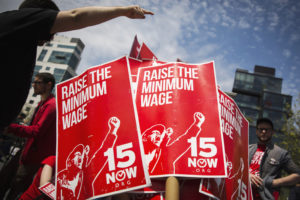by WorldTribune Staff, July 29, 2016
The $15 minimum wage pushed by the Democratic Party and standard-bearer Hillary Clinton would lead to the loss of more than 7 million jobs, a Heritage Foundation report said.
Democrats on July 25 approved a party platform backing the $15 minimum wage following a multi-million dollar campaign by the Service Employees International Union and pressure from supporters of socialist Sen. Bernie Sanders.

According to the report, a $15 minimum wage (more than double the current federal minimum of $7.25) would effectively raise labor costs to more than $18 an hour per employee, after payroll taxes and other mandates.
“Businesses would respond to these higher labor costs by reducing employment of affected workers by over one-sixth, thus eliminating approximately 7 million full-time-equivalent (FTE) jobs by 2021. Forcing employers to pay starting wages of $15 per hour would make many less skilled workers unemployable,” labor policy analyst James Sherk wrote for the Heritage Foundation.
“If Congress raised minimum starting wages to $15 — and total hiring costs to $18.61 per hour — businesses would respond by eliminating positions, cutting hours, and looking for new ways to implement labor-saving technology,” the report said. “Some companies might have to face shutting down or leaving America entirely to cope with the additional expenses.”
During the primary campaign, Clinton had backed an increase to $12 an hour and once told an audience in Iowa that the $15 rate would cause “job loss and dislocation.” She later backtracked, however, saying “there is no evidence that the minimum wage being increased costs jobs.”
Sherk estimated that an increase to $15 would affect more than 30 percent of all workers. The move would make it more costly to hire new and entry level workers, but would also drive wages up for more highly-skilled workers that earn above the minimum wage, but below the $15 hourly rate.
Sherk called the Democrats’ proposal “unprecedented” in its scope.
“Federal and state minimum wages typically cover between 4 percent and 10 percent of the workforce,” the report says. “The minimum wage has never before come close to covering such a large share of workers. Whether expressed in real dollars or as a proportion of workers directly affected, no state has experienced minimum starting wages this high.
“When a good or service becomes more expensive, consumers buy less of it. Employers react the same way when wages rise.”
Michael Saltsman, research director at the Employment Policies Institute, said that Sherk’s report follows the consensus among labor experts, including liberal economists on the $15 minimum wage.
“This report confirms what economists have told us for years: Creating an unreasonably high starting wage of $15 an hour costs jobs. Even Democratic economists understand this — it’s unfortunate that the party faithful do not,” Saltsman said.
